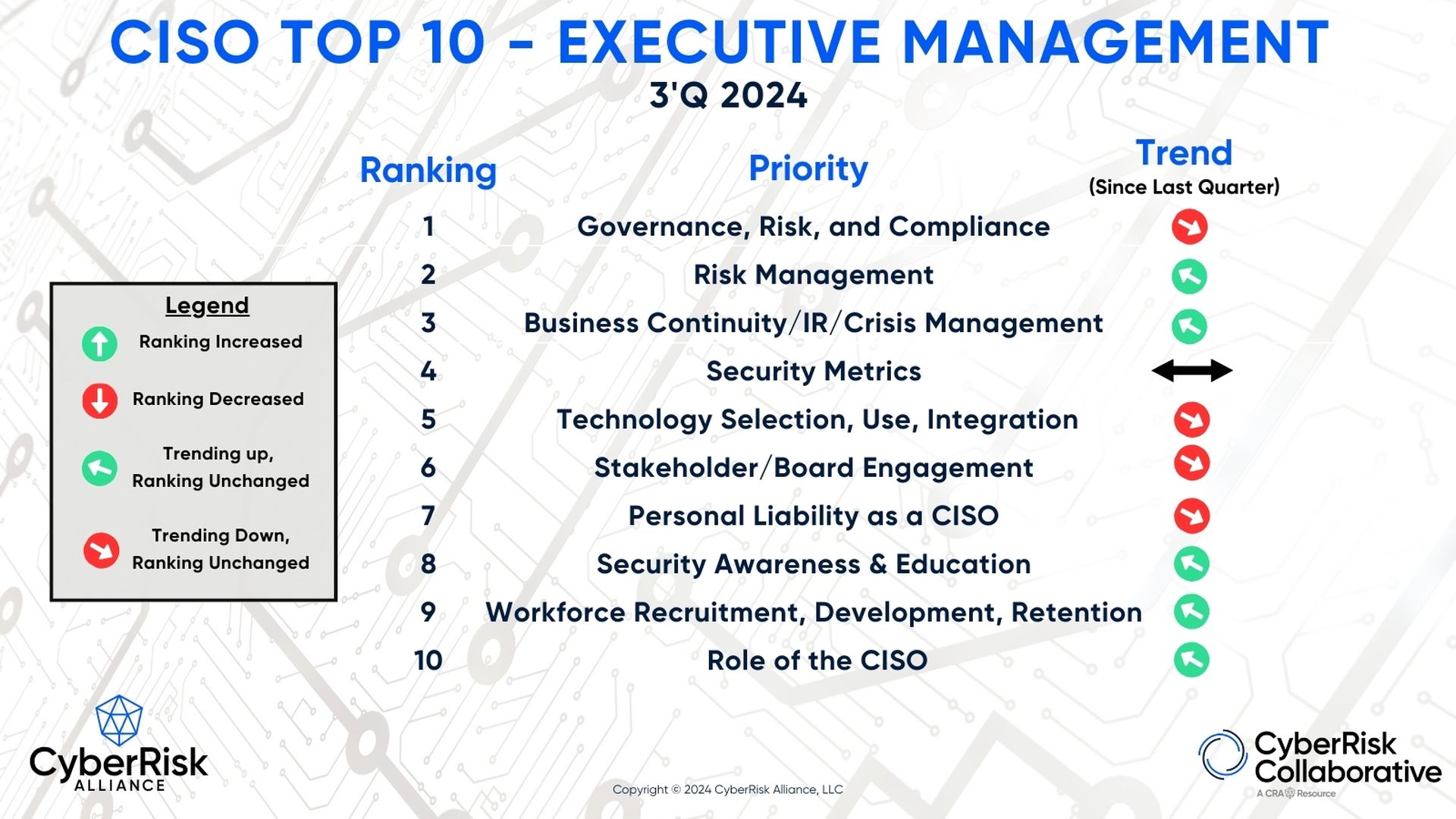As the cybersecurity landscape grows more complex and interconnected, the role of the Chief Information Security Officer (CISO) continues to expand, evolving from a primarily technical position into one that demands a strategic approach to risk, compliance, and technology. The CISO Top 10 reports for Q3 2024 provide critical insights into the key areas where today’s CISOs are focusing their efforts, both from a management and technology perspective.
For the third quarter of 2024, Governance, Risk, and Compliance (GRC) remains at the forefront of CISO priorities, underscoring its enduring importance in maintaining a resilient cybersecurity posture. With regulatory scrutiny tightening and threat landscapes becoming more unpredictable, organizations must ensure their operations align with both external regulations and internal policies. An effective GRC strategy isn’t just about ticking boxes—it’s about creating a culture of accountability and readiness.
CISOs are recognizing the increasingly interconnected nature of these risks. Governance doesn’t operate in a vacuum; it ties into Risk Management, which ranks second on the executive management list. The gap between these two areas is shrinking, reflecting a more holistic view of cybersecurity that integrates compliance, risk assessment, and incident response into a unified approach. No longer can organizations afford to treat cybersecurity as a siloed function—it must be a foundational element of the business.
Another key area of focus is Business Continuity and Incident Response, ranked third. In today’s world, where cyberattacks can cripple entire operations in a matter of hours, having a robust incident response plan is not optional; it’s critical. This area’s steady position in the top three highlights the ongoing necessity for preparedness, ensuring that organizations can recover quickly from disruptions, whether they stem from a cyber incident or a natural disaster.
On the technology front, the integration of emerging technologies remains a top concern for CISOs. Leading the list for Q3 2024 is Automation, AI, and Machine Learning. These technologies aren’t just buzzwords—they are the new frontier in cybersecurity. Automation is transforming the way organizations detect and respond to threats, while AI and ML enable more sophisticated predictive models that can foresee potential vulnerabilities before they’re exploited.
Cloud Security holds the second spot, continuing its critical role as organizations migrate more of their infrastructure and data to cloud environments. Cloud security strategies are becoming increasingly sophisticated, focusing on protecting against breaches, misconfigurations, and ensuring compliance with a complex array of regulations. As more workloads move to the cloud, CISOs must ensure that their defenses are agile enough to adapt to the fluid nature of these environments.
Tied to cloud security is Identity and Access Management (IAM), which ranks third. With the proliferation of remote work and cloud services, controlling who has access to what data is essential to prevent unauthorized users from exploiting systems. Robust IAM practices are critical not only for security but for maintaining trust and regulatory compliance.
What’s striking about these reports is the growing convergence between executive management and technology priorities. Whether it’s Security Metrics or Data Security, the alignment of these issues demonstrates that today’s security challenges are not just technical—they are deeply intertwined with broader business operations and risk management efforts. CISOs are increasingly expected to act as both security leaders and strategic advisors, helping to navigate the balance between innovation and risk.
The focus on Personal Liability also highlights the personal stakes for CISOs in today’s regulatory environment. As regulatory bodies ramp up their scrutiny of cybersecurity practices, CISOs face heightened pressure to ensure that their organizations are both secure and compliant. Failure to do so could result in not just financial penalties for the company but personal liability for the CISO.
Looking ahead, the integration of technologies like AI with traditional security measures such as IAM and cloud security will continue to shape the future of cybersecurity. CISOs must remain agile, adopting a forward-thinking approach to ensure their organizations are protected against evolving threats. The narrow gaps between these top priorities indicate that no single area can be ignored—security today requires a multi-faceted, interconnected approach that spans governance, technology, and people.
- [SC Media Perspectives columns are written by a trusted community of SC Media cybersecurity subject matter experts. Read more Perspectives here.]
As the role of the CISO expands, so too does the importance of leadership in fostering a cybersecurity-aware culture. Whether through Security Awareness and Education initiatives or Workforce Recruitment and Retention efforts, security leaders must focus not just on technology but also on empowering their teams and educating stakeholders.
The CISO Top 10 reports make one thing clear: cybersecurity is no longer just a technical issue—it’s a fundamental business concern. The CISOs who thrive in this environment will be those who can navigate both worlds, aligning their cybersecurity strategies with the broader goals of the organization to build a resilient, future-ready enterprise.
